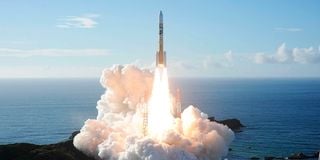
In this handout photograph taken and released on July 20, 2020, by Mitsubishi Heavy Industries an H-2A rocket carrying the Hope Probe known as "Al-Amal" in Arabic to explore Mars, blasts off from Tanegashima Space Centre in southwestern Japan.
More than 42,000 Africans’ names are in a spacecraft launched from the United States on Monday, destined for a faraway moon called Europa that orbits Jupiter.
After a successful launch, the vessel christened Europa Clipper is now travelling in space as it embarks on a journey of 2.9 billion kilometres. The journey will see it use the gravitational pulls of Mars and Earth to get the propulsion to head to the Jupiter system.
Africa’s top contributors to the names list are South Africa with 13,192, followed by Egypt (4,889) then Kenya (3,271), Nigeria (3,131), and Morocco (2,970). The total submissions from Africa were 42,231 names.
Other countries in the top 10 in Africa in terms of names submission are Madagascar (2,207), Algeria (2,130), Tunisia (1445), Mali (954) and Ethiopia (901). The bottom five are Sao Tome and Principe with seven, Guinea-Bissau (12), Comoros (14), Equatorial Guinea (16) and the Central African Republic that is tied with Burundi at 20.
The names will be attached to a poem written by American Ada Limón. But the poem and the names in the spacecraft are not in a typical roll that someone can read with the naked eye.
“They will be stencilled onto microchips mounted on the spacecraft,” America’s National Aeronautics and Space Administration (Nasa) said as it called for names.
“Once all the names have been gathered, technicians in the Microdevices Laboratory at Nasa’s Jet Propulsion Laboratory in Southern California will use an electron beam to stencil them onto a dime-size silicon microchip. Each line of text is smaller than 1/1000th the width of a human hair (75 nanometres).”
Nasa had made the call in 2023, asking whoever was interested in sending their name to enter it in their portal. A total of 2,620,861 names were sent from across the globe. US residents sent 767,474 names.
Once a person sent their name, Nasa replied in an email: “Your name will be on board Nasa’s Europa Clipper spacecraft as it travels 1.8 billion miles to explore Jupiter’s icy moon!”
That means that the two million names will be contained in an item the size of a coin.
The spacecraft is almost the size of a basketball court due to the need for huge solar panels. It has 24 engines.
“It extends 100 feet (30.5 metres) from one end to the other and about 58 feet (17.6 metres) across. That’s about the size of a basketball court, thanks in large part to the solar arrays, which need to be huge so they can collect enough sunlight while near Jupiter to power the instruments, electronics, and other subsystems,” Nasa says.
The Europa Clipper will not land but rather fly by the Europa moon, which has been found to have water deep into its icy surface. This will be part of the investigation on whether the moon can support life.
“Europa has the highest chance of life in our Solar System because of the thick, protective shell of ice that covers its ocean,” billionaire Elon Musk, whose Space X company was the star of the launch, tweeted on Monday evening.
Europa is one of Jupiter’s 95 moons. Its diameter, Nasa says, is about 90 percent of the Earth’s only moon.
Nasa typically asks the world to send names to be sent to space. Some of its recent calls involve the Artemis and Viper missions to the moon and the Parker Solar Probe that was to investigate the sun.


